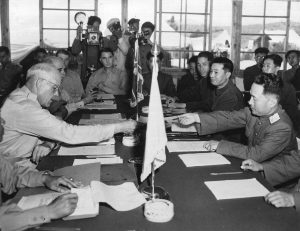This month marks the 70th anniversary of the Korean Armistice Agreement, signed on July 27, 1953. The armistice suspended the Korean War, which had started three years earlier in June 1950. It marked a cessation of combat between armed forces on the Korean Peninsula. However, an armistice does not mean a legal and permanent end to a war, and thus the peninsula has been technically still at war since the 1953 armistice. This has kept the two Koreas in an ambiguous political and military state.
Why was the Korean War not permanently ended in 1953 with a peace treaty? Part of the answer is rooted in the role of South Korea in settling this military conflict. A close look at who signed the Armistice Agreement and what happened after the truce gives us a hint – and also helps us better understand the political developments in and around the Korean Peninsula caused by this lasting ambiguity.
The Korean War broke out in 1950, but the peninsula had been already divided by the two great powers, the United States and the Soviet Union, since 1945. The two powers occupied each half of the peninsula immediately after Japan, which had colonized Korea since 1910, was defeated in the Pacific War and surrendered in 1945. The division of Korea along the 38th parallel was further consolidated in 1948 by two separate governments established in the northern and southern parts of the peninsula, with respective support from Moscow and Washington.
North Korea (formally the Democratic Republic of Korea, DPRK), founded under the leadership of Kim Il Sung, and South Korea (the Republic of Korea, ROK), founded under Syngman Rhee, shared a common goal of unifying the whole Korean Peninsula – but each wanted his own government to rule.
On June 25, 1950, the Korean War started with the Korean People’s Army (KPA) from the North crossing the 38th parallel to attack the South. It’s interesting to note, however, that both North and South Korea saw the war as an opportunity to unite the divided peninsula under their own control. On the first day of the war, President Rhee even told U.S. Ambassador John J. Muccio that “perhaps the present crisis presented the best opportunity for settling the Korean problem for once and all.”
The Korean War started as a civil war between the two Koreas. However, it quickly escalated into an international war as other countries became directly or indirectly involved, which meant the settlement of the conflict became more difficult and complicated later.

































